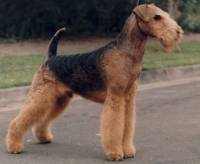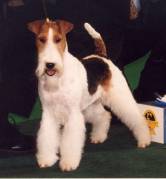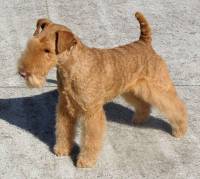Long Legged Terriers
 Airedale Terrier
Airedale Terrier
In normally constructed breeds, theoretically the shoulder blade and upper arm are the same length. This section discusses the 'Terrier Front' which has the upper arm shorter than the shoulder blade.
In breeds other than terriers where a 'showy' high head carriage is desired, the upper arm is shortened, either correctly or incorrectly, to enable this 'showy' head carriage to occur. But in the case of all long legged terrier breeds, because of a functional use of this short upper arm, it is a requirement. That is why this front is called a 'terrier front'.
Terrier Front
For the purposes of discussing the Terrier Front, it is necessary to divide terriers into 3 sub-groups:
- The Bull Terrier Breeds
- The short legged Terrier Breeds
- The long legged terriers which are discussed below.
All terrier breeds that are not in categories 1 and 2 above fit into this section. These are:
- Kerry Blue Terrier
- Soft Coated Wheaten Terrier
- Bedlington Terrier
- Manchester Terrier
- Airedale Terrier
- Irish Terrier
- Border Terrier
- Lakeland Terrier
- Parson Russell Terrier
- Tenterfield Terrier
- Welsh Terrier
- Fox Terrier (Smooth and Wire Coat)
 Greyhound
Greyhound
These breeds are roughly in order. Those at the top of the list have a humerus or upper arm which is closer to equal in length to the scapula than the breeds at the bottom of the list. But all of these terrier breeds should have a somewhat shortened humerus when compared to a dog with a normal length humerus like the Greyhound on the right.
 Long Legged Terrier
Long Legged Terrier
So the length of the humerus of any long-legged terrier should be shorter than its shoulder blade or scapula. This has nothing to do with the physical size of these terriers. In other words the shortening of the humerus is independent of the 'lay of shoulder'.
How Long-Legged Terriers Dig
 Terrier Digging in Burrow
Terrier Digging in Burrow
Remembering terrier breeders selected dogs whose function was to dig, this shortened humerus allowed the terrier's elbows to work clear of the deepest part of the chest when digging within the confines of a tunnel. Here the terrier digs whilst lying on its chest as shown in the diagram. In this position, the terrier's elbow must not impede the terrier's ability to dig within this confined space. Note
- The terrier's pasterns are shortened to assist not only the terrier's ability to dig, but also its ability to maintain kinetic balance when moving above ground.
- The length of the humerus of a long-legged terrier is independent of the physical size of the terrier, the lay of shoulder or the length or angle of the shoulder blade
Comparison between Fox, Welsh and Lakeland Terriers
These 3 Terriers are directly compared here because although they appear alike, they differ not only in origin but also in several physical aspects. So it is important to compare these differences.
| Terrier | Fox Terrier (Wire) | Welsh Terrier | Lakeland Terrier |
|---|---|---|---|
|
|
|
|
|
| Background | Old English White Terrier (rough coated) | Old English Black and Tan Terrier (rough coated) | Terrier of the Border Region |
| Head Proportions | Little difference in length between skull and foreface | Medium length from stop to end of nose. Jaws rather deep. | Length of head from stop to tip of nose not exceeding that from occiput to stop |
| Ears | Top line of folded ears well above level of skull (Button Ears) | Set in fairly high and carried forward close to cheek | Set neither too high or too low on head |
| Chest | Deep not broad | Good depth and moderate width | Chest reasonably narrow |
| Body Proportions | Back short | Back short | Back moderately short |
| Height and Weight | Dogs not exceeding 15.5 inches at shoulder, bitches slightly less. Ideally 18 lbs. | Not exceeding 15.5 inches at shoulder. 20 - 21 lbs. | Not exceeding 14.5 inches at shoulder. Dogs 17 lbs, bitches 15 lbs. |
| Colour | White predominates with black, black and tan or tan markings | Black and tan or black grizzle and tan | Black and tan, blue and tan, red, wheaten, red grizzle, liver blue or black |
References and Further Reading
Published as Jane Harvey - 'Terrier Fronts - Shortened humerus has specific purpose' Published in Dog News Australia (Top Dog Media Pty Ltd Austral NSW) Issue 4 January 2018, Page 10


